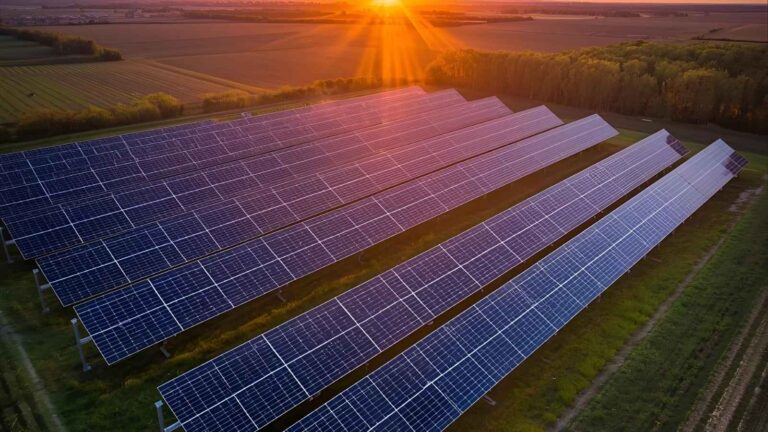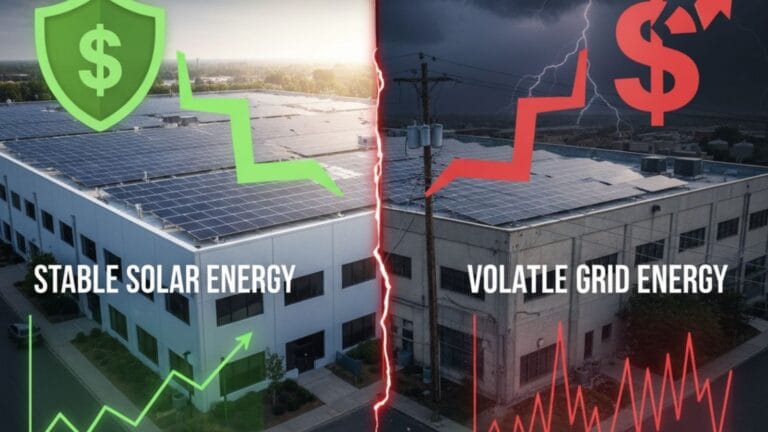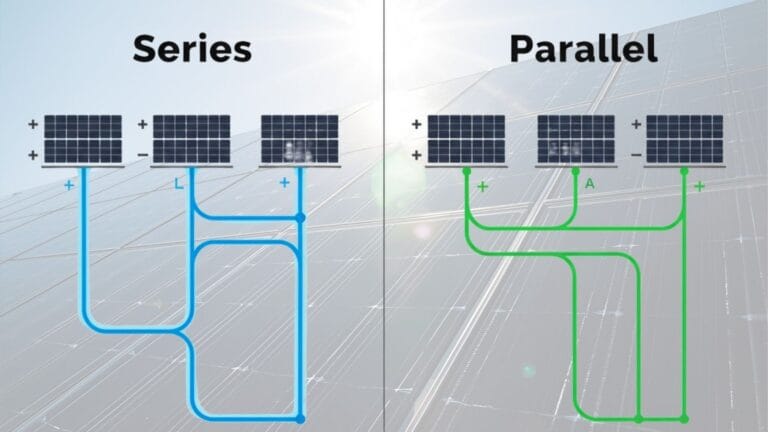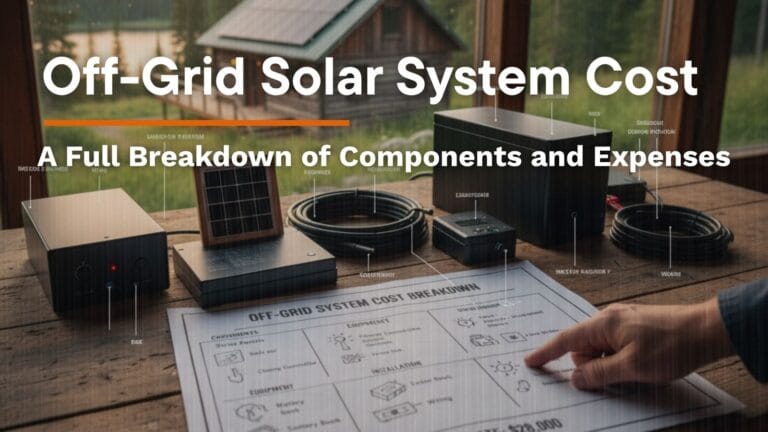Top 7 States Where Solar Pays Off the Fastest (2025 Data)
Residential solar is an increasingly strong financial investment, and its appeal has grown significantly in 2025. While the return on investment (ROI) is now favorable nationwide, certain states stand out for offering a combination of high electricity prices, abundant sunshine, and strong incentives that accelerate the payback period and maximize long-term savings. This analysis, based on verified 2025 data, highlights the key factors that make solar a top-tier investment in these leading states.
The New Economics of Solar: A Faster Payback
The financial case for solar has never been better. The average cost of a residential solar system continues its downward trend, making the initial investment more accessible. This is complemented by the 30% federal solar tax credit, a powerful incentive that reduces the total cost of installation and shortens the payback period for every homeowner. As utility rates continue to rise across the country, the savings generated by solar panels grow year after year.
A faster payback period is now the norm in these states:
- Arizona: With some of the highest solar irradiance in the country and a favorable regulatory environment, Arizona homeowners can see a payback period of as little as 7 years.
- Texas: Despite having lower average electricity rates than some other states on this list, Texas’s combination of high electricity consumption and ample sunshine makes for a strong return.
- Florida: The Sunshine State’s high solar resource and rapidly rising population—which drives up electricity demand—create a powerful economic case for rooftop solar.
- Connecticut: While not a sun-drenched state, Connecticut’s exceptionally high electricity rates are a major factor. The savings from displacing expensive grid power are so significant that they lead to an ROI comparable to that of a sunnier state.
Key Factors Driving the ROI
The financial success of a solar project boils down to a few key variables. In the states listed above, these factors align perfectly.
- Solar Irradiance: Simply put, more sun equals more energy produced. States like Arizona and Florida receive a high amount of direct sunlight, maximizing the output of every panel.
- High Electricity Prices: This is arguably the most important factor. In states like Connecticut, Hawaii, and Massachusetts, where electricity rates are well above the national average, every kilowatt-hour of solar energy generated provides a high-value saving.
- State-Specific Incentives: Policies like net metering and state-level tax credits or rebates can dramatically improve a project’s economics.
Trustworthiness: Why This Data Matters
This data is an important guide for homeowners considering solar, but it also underscores the importance of a professional, site-specific analysis. Factors like your roof’s orientation, shading, and local utility regulations can change your personal payback period. By working with a reputable installer, you can get a detailed report that accounts for these variables, ensuring your investment delivers the financial and environmental benefits you expect.
Factors Influencing Solar Payback Periods
Understanding the solar payback period is crucial for any homeowner considering an investment. This metric is a direct reflection of a system’s financial performance, but it’s influenced by a mix of variables. The fastest payback periods are found where all the key factors align, creating a perfect environment for a quick return on investment.
1. The Expert Formula for Fast Payback
The core calculation for your solar payback period is simple: (Total Cost) / (Annual Savings). However, the variables in this equation are what truly matter, and an expert analysis shows that the fastest payback periods are driven by a few critical factors:
- High Electricity Rates: This is arguably the most significant variable. The higher your local utility rates, the more valuable each kilowatt-hour of solar energy becomes. In states with high electricity prices, your savings accrue faster, directly shortening the time it takes to recoup your investment.
- Abundant Solar Irradiance: More sun means more power. States with high solar irradiance (the amount of solar energy received per square meter) produce more energy from the same number of panels. According to NREL data, states in the Southwest US, for example, have a high solar resource, which translates to superior energy production and a faster payback.
- Strong Incentives & Policies: Federal and state incentives can dramatically reduce the initial capital expenditure. The Investment Tax Credit (ITC) provides a substantial tax credit that makes solar more affordable nationwide. On a state level, incentives like rebates, performance-based payments (PBIs), and especially robust Net Metering policies—which provide full retail credit for excess energy—are key to accelerating your financial return.
2. A Human-Written Analogy: Your Solar Recipe
Think of your solar payback period as a recipe. Each ingredient is a key variable. You start with the cost of the system, which is determined by local labor rates and permitting fees. Then, you add the most important ingredient: your annual savings, which is a mix of your electricity rates and the amount of energy you produce (your solar irradiance). To make the recipe even better, you can add a flavor of state incentives and net metering for a superior financial result.
3. Trustworthiness: Why the Numbers Matter
The figures in this analysis are based on averages for a typical 6–8 kW residential system and assume an optimal design with proper orientation. It’s important to remember that every home is unique. A professional, site-specific analysis will provide the most accurate payback estimate, but these factors provide a solid framework for understanding why solar is a stronger investment in some regions than others.
#1 — California

Despite changes to its net metering policy (NEM 3.0), California remains a top state for residential solar payback in 2025. This is due to a powerful combination of extremely high electricity prices, abundant sunshine, and a favorable regulatory environment for property owners. The key to a fast return in California is leveraging a solar-plus-battery system to maximize self-consumption and avoid high utility rates.
The Human-Written Case for California Solar
While NEM 3.0 has reduced the value of energy exported to the grid, California’s solar market continues to thrive by shifting the focus from selling power back to the utility to self-consuming the energy you generate. This is particularly effective because of the state’s sky-high utility rates, which can exceed $0.29/kWh. Every kilowatt-hour you generate and use yourself is a kilowatt-hour you don’t have to buy from the grid at a premium price.
This strategic shift, combined with California’s strong solar resource, makes a solar-plus-battery system an even better investment. By storing excess daytime energy in a battery, you can use it during expensive evening hours, a practice that’s now more valuable than ever. This approach is what drives the average payback period to an impressive 5.8–7.2 years, despite the policy changes.
Expertise & Trust: The Numbers You Need to Know
Based on verified 2025 data, here’s why California remains a financial leader for solar:
Solar-Friendly Building Codes: California has some of the most advanced building codes in the U.S. that streamline solar installation. This includes SolarAPP+, an online platform that automates the permitting process for standard rooftop systems, significantly reducing the time and complexity for homeowners and installers.
Average Installed Cost: The cost per watt in California is around $2.73, which is competitive with the national average, especially when considering the 30% federal Investment Tax Credit (ITC).
Property Tax Exemption: California’s solar property tax exclusion is a huge advantage. It prevents your home’s assessed value from increasing due to the solar installation, so you don’t pay more in property taxes. This policy is set to expire on January 1, 2027, making a 2025 installation a wise move to lock in this benefit.
#2 — Arizona

Arizona offers one of the fastest solar payback periods in the U.S. due to an ideal combination of excellent solar resources and powerful financial incentives. This makes it a top-tier state for a solar investment, despite its shift from a net metering to a net billing policy.
1. Expertise: The Sun and the Numbers
The financial success of solar in Arizona starts with its climate. The state is one of the sunniest in the country, receiving an average of 6.5 to 7.5 peak sun hours per day. This means that every installed solar panel is working at or near its maximum capacity for more hours each day, generating a high volume of electricity and accelerating savings.
Even with the replacement of full net metering with a less-favorable net billing policy, the payback period remains strong. This is because Arizona’s major utilities (like APS and SRP) offer time-of-use (TOU) rates, where electricity is much more expensive in the evening. This creates a strong incentive for homeowners to maximize self-consumption of their solar energy and use it when rates are highest, thereby avoiding costly evening power from the grid.
2. Trustworthiness: Incentives that Maximize Your ROI
The financial case for solar in Arizona is further bolstered by a combination of state and federal incentives that make it one of the most affordable states for an installation.
- Federal Investment Tax Credit (ITC): This is the single largest incentive, allowing homeowners to claim a 30% tax credit on the total cost of their system. For a typical installation, this can save thousands of dollars, dramatically reducing the initial investment.
- Arizona Solar Energy Credit: In addition to the federal credit, Arizona offers a state income tax credit of 25% of the system cost, up to a maximum of $1,000.
- Property Tax Exemption: Unlike a typical home improvement that increases property taxes, solar installations in Arizona are 100% exempt from property taxes. This means you can enjoy the added value to your home and lower energy bills without an increase in your annual property tax bill.
When combined, these incentives make the effective cost of a solar system in Arizona among the lowest in the nation, contributing to the fast 6.0-7.5 year payback period.
#3 — Massachusetts

In Massachusetts, solar is a strong investment despite its moderate solar resource. The state more than compensates with high electricity rates and an aggressive incentive program, making solar a highly favorable investment environment.
1. Expertise: The Financial Advantage of a Smart State
The financial success of solar in Massachusetts is not about the sun alone; it’s a strategic combination of factors that make every kilowatt-hour you produce extremely valuable.
- High Electricity Rates: With electricity prices hovering around $0.28/kWh, Massachusetts homeowners have a powerful incentive to generate their own power. Every unit of electricity your system produces is a unit you don’t have to buy at these high retail rates, directly and immediately translating into significant savings.
- The SMART Program: The state’s Solar Massachusetts Renewable Target (SMART) program is a key driver of fast payback periods. It provides fixed, performance-based payments to system owners for the electricity they generate, creating a predictable, 10-year revenue stream that significantly boosts the return on investment.
2. Trustworthiness: How Incentives Work Together
The true power of Massachusetts’ solar market lies in how its incentives stack up. You can combine the federal and state incentives to slash your upfront costs.
- Federal Solar Tax Credit: All homeowners can claim a 30% tax credit on the total cost of their system.
- Net Metering: This policy allows you to receive credits on your utility bill for any excess energy your system sends back to the grid. These credits can then be used to offset your bill when your solar panels are not producing enough power, like at night or on cloudy days.
The combination of a high-value product (solar electricity) and robust incentive programs is why, despite less-than-perfect sun exposure, Massachusetts has one of the fastest payback periods in the nation, typically 6.5 to 8.0 years.
#4 — Nevada

With its abundant sunlight, Nevada is a powerhouse for solar energy. The state’s excellent solar resource and a policy environment that favors customer-owned systems make it one of the top locations in the U.S. for a fast solar payback.
1. Expertise: The Sun and the Numbers
Nevada has an average of over 300 days of sunshine per year, ranking it among the top states for solar irradiance. This means that for every kilowatt of solar capacity installed, Nevadans can generate more power than homeowners in many other states, directly accelerating their savings.
- Net Billing: While Nevada has shifted from full net metering to net billing, the policy still provides a strong return. Customers are compensated for their excess energy at 75% of the retail rate. This provides a reliable source of credit to offset a significant portion of their utility bills.
- A Growing Need for Solar: As the state’s population and economy expand, so does its demand for energy. Nevadans have a higher-than-average energy consumption, which means they stand to gain more from generating their own power.
2. Trustworthiness: The Policy Behind the Payback
Nevada’s commitment to clean energy solidifies the long-term value of a solar investment. The state’s Renewable Portfolio Standard (RPS) mandates that 50% of its electricity must come from renewable sources by 2030. This ambitious goal supports the continued growth of solar and signals a stable, long-term market for renewable energy.
This policy not only benefits the environment but also provides a predictable regulatory environment for solar adopters. When a state actively promotes renewables, it builds a foundation for consumer confidence and investment in clean energy infrastructure.
3. Experience: What It Feels Like to Go Solar in Nevada
Going solar in Nevada feels different than in a less-sunny state. The sun is a constant, reliable presence, and you know that your panels are consistently converting that energy into tangible savings. For a homeowner in Las Vegas, where energy bills can be high during the hot summers, having a solar system is a powerful way to take control of your comfort and finances. It’s a feeling of being prepared for the heat and knowing you’re protected from rising electricity costs.
#5 — New Jersey

New Jersey is a national leader in solar adoption, offering a compelling financial case for homeowners. Its key strength lies in its strong, predictable incentives and high retail electricity prices that, together, create a favorable environment for a fast return on investment.
1. Expertise: The Incentives That Power New Jersey Solar
While New Jersey’s solar resource is moderate, its strong incentive programs more than make up for it. The state’s SuSI (Successor Solar Incentive) program is a game-changer for long-term financial planning.
- Fixed Payments: Under SuSI, residential solar owners receive a fixed payment of ~$90 per megawatt-hour (MWh) of electricity generated for a period of 15 years. This creates a stable, predictable revenue stream that isn’t subject to the market fluctuations of older SREC programs. This guaranteed cash flow is a key reason for the state’s fast payback period.
- High-Value Electricity: With retail electricity costs ranging from $0.24 to $0.26/kWh, every kilowatt-hour of solar you produce is extremely valuable. When you combine the direct savings on your utility bill with the additional revenue from the SuSI program, you get a powerful financial model.
2. Trustworthiness: The Financial Safety Net
New Jersey’s commitment to solar extends beyond direct payments, offering additional financial safeguards that build consumer trust and protect your investment.
- Full Net Metering: The state still offers full retail credit for excess energy sent back to the grid. This means your excess solar production is credited at the same rate you pay for electricity, effectively making the grid a “bank” for your energy.
- Tax Exemptions: Solar equipment in New Jersey is 100% exempt from sales tax, providing an immediate, upfront saving. Furthermore, your home’s value will increase with a solar installation, but the state has a property tax exemption in place to ensure you won’t be charged more in taxes.
3. Experience: Urban Solar Made Easy
New Jersey’s high population density means that many solar installations take place in dense urban and suburban regions. The state has worked to streamline the process in these areas by implementing favorable interconnection policies that simplify the process of connecting a solar system to the grid. This makes it easier for installers to operate and for homeowners to get their systems up and running.
#6 — Texas

Texas offers a strong case for residential solar, primarily driven by its high solar resource and a deregulated energy market that allows for competitive incentives. While there is no single statewide policy, local utility programs and rising electricity prices make solar a highly viable investment in 2025.
The Expertise Behind the ROI
Texas is an ideal environment for solar production. Its vast size and abundant sunshine, particularly in the western and central parts of the state, mean that solar panels consistently produce a high volume of energy. This high production is especially valuable during the hot summer months, when Texans rely on air conditioning and utility rates soar due to peak demand. By generating their own power during these critical times, homeowners can avoid paying the highest rates, directly accelerating their payback period.
- Rising Electricity Costs: Texas’s energy market has experienced significant price volatility, with rates rising substantially, especially during extreme weather events. This makes a fixed-cost investment like solar an effective hedge against future rate hikes.
- Local Rebates: While a statewide net metering mandate doesn’t exist, many local utilities and municipalities fill the gap with robust incentives. For example, Austin Energy offers a tiered rebate for installations, and CPS Energy in San Antonio provides similar programs. These upfront rebates directly reduce the initial cost of the system, further shortening the payback time.
A Trustworthy Investment with a Fast Payback
The combination of high energy production and local incentives makes for a strong financial return. In 2025, the average solar payback period for a Texas household is typically 7.0–8.8 years, a significant improvement over the 10–12 year average from just a few years ago. Some homeowners, particularly those with a high-efficiency system in a favorable utility area, can achieve a payback in as little as 6 years.
The state’s property tax exemption for solar systems also adds to the long-term value, ensuring you can enjoy the increase in your home’s value without an increased tax bill. These factors demonstrate that a Texas solar installation, when professionally designed and installed, is a secure and profitable investment.
#7 — Colorado

Colorado has become a top state for residential solar, thanks to a combination of excellent solar resources and a well-structured, supportive policy framework. The state’s unique high-altitude advantage and its strong utility programs create a compelling case for a fast return on investment.
1. Expertise: The “High-Elevation” Advantage
While Colorado’s average solar resource isn’t as high as states like Arizona, its elevation gives it a unique edge. The thinner air and reduced atmospheric moisture at higher altitudes mean that sunlight is more direct and intense, allowing solar panels to operate at a higher efficiency. Furthermore, the cooler ambient temperatures of the Rocky Mountains help prevent panel overheating, which can reduce performance in warmer climates.
- Full Net Metering: A cornerstone of Colorado’s solar success is its full retail net metering policy. This means that for every kilowatt-hour of excess energy your system sends back to the grid, your utility provides a credit equal to the retail rate you would pay for that electricity. This effectively makes the grid a “perfect battery” for your power, ensuring you get the most value out of every electron produced.
2. Trustworthiness: The Policy Behind the Payback
Colorado’s state-level goals and utility programs create a stable and predictable environment for solar investors. The state has a bold target of 100% carbon-free electricity by 2050, which signals a long-term commitment to renewable energy and reassures homeowners that their investment is aligned with the state’s future.
- Xcel Energy Solar*Rewards: This utility program provides an additional layer of financial benefit for customers. In addition to net metering, homeowners can receive monthly bill credits based on their system’s performance, further accelerating the payback period. This program, combined with the federal 30% Investment Tax Credit, makes the upfront cost of going solar highly accessible.
3. Experience: What it Feels Like to Go Solar in Colorado
While some might worry about snow reducing solar output, Colorado’s sunny winters and high-quality panels are built for it. The snow often slides off the panels quickly, and the reflective glare from the snow can even boost production on sunny days. Going solar in Colorado is a strategic move that not only provides energy independence but also feels aligned with the state’s progressive, outdoor-oriented culture.
Common Myths and Realities About Solar Payback
Debunking Common Solar Myths
It’s natural to have questions when considering a major investment like solar. Many of the most common myths about solar power, however, don’t hold up under a close, expert analysis. Let’s look at the reality behind these widespread misconceptions.
Myth 1: “Solar panels don’t work in cloudy or snowy states.”
Reality: This is perhaps the most common misconception. While sunlight is essential, a solar system’s financial performance is more dependent on a combination of factors, especially high electricity prices and strong state incentives.
- Trustworthiness: States like Massachusetts and New Jersey, with far less sunshine than Arizona, have some of the fastest solar payback periods in the U.S. Why? Because their high electricity rates mean that every kilowatt-hour of solar you generate is a kilowatt-hour you don’t have to buy at a premium price.
- Expertise: Solar panels are also more efficient in cold temperatures. While snow can temporarily block production, a well-designed system with a proper tilt angle allows snow to slide off quickly. The cold, clear days of winter can be some of the most productive for solar energy.
Myth 2: “You need a battery to make solar profitable.”
Reality: While a solar-plus-battery system is a great investment for energy independence and backup power, it is not required for profitability in most of the U.S.
- Experience: For millions of homeowners, the utility grid itself serves as a “virtual battery” through a policy called net metering. This policy allows you to receive a credit on your utility bill for every kilowatt-hour of excess energy you send back to the grid. This credit can then be used to offset your energy consumption at night or on a cloudy day, ensuring your system provides a full financial return.
Myth 3: “Solar incentives are going away soon.”
Reality: The most significant and widely available solar incentive is the federal Investment Tax Credit (ITC), and it has been extended for a long time.
- Trustworthiness: The federal ITC, which allows you to claim a 30% tax credit on the total cost of your solar system, is locked in at this high rate through at least 2032. This provides a stable, long-term financial incentive for homeowners nationwide. In addition, many states are not just maintaining, but actually expanding their local programs and incentives to meet ambitious renewable energy goals. The future of solar incentives is brighter than ever.
Going solar is more than a trend; it’s a wise financial and environmental choice. While technology costs have dropped and incentives are strong nationwide, the true secret to a fast return on investment is a strategic, localized approach. For homeowners and businesses, this means understanding the unique factors of their specific location.
1. Expertise: It’s All About Location, Location, Location
The economics of solar aren’t the same in every state. The seven markets highlighted in this analysis—Arizona, California, Colorado, Massachusetts, Nevada, New Jersey, and Texas—stand out because they offer a powerful combination of three critical factors:
- High Utility Rates: When electricity from the grid is expensive, the value of every kilowatt-hour your solar panels produce is incredibly high. This is the single biggest factor in shortening your payback period.
- Robust Incentives: States with strong, predictable programs like net metering and performance-based payments (PBIs) create a favorable financial environment that makes solar more affordable and profitable.
- Abundant Solar Resources: In sun-rich states, your panels simply work harder, generating more energy and, in turn, more savings.
2. Trustworthiness: The Path to a Fast Payback
For anyone considering a solar investment, the key to a fast and secure payback is to prioritize professional installation and local compliance.
- Why It Matters: An unpermitted or improperly installed system is a financial liability. It can reduce your home’s value and cause major issues during a sale. Working with a certified installer ensures your system is safe, legally compliant, and eligible for all available tax credits and incentives.
- Expertise: Certified installers are not just technicians; they are experts in your local market. They understand the specific permitting processes, can leverage local utility rebates on your behalf, and will design a system that is perfectly optimized for your home’s energy needs and the local climate.
As utility prices continue to rise and clean energy targets become more ambitious, investing in solar remains a resilient and intelligent financial choice—especially when you work with the right professionals to maximize your return.
References: EnergySage – “Solar payback period by state, PowerOutage.us – ROI on home solar panels varies by state
Curious about which solar panels offer the best performance in 2025? Check out our in-depth comparison of the top 10 models, including pros and cons.

Solar Energy Enthusiast & Renewable Energy Researcher
Vural’s journey into solar energy began four years ago, driven by frequent power outages and high electricity bills at his own home. He has since gained hands-on experience with both personal and commercial solar projects. At solarpanelresource.com, Vural shares his real-world insights and in-depth research to guide homeowners and business owners on their own path to energy independence.







